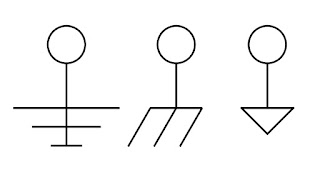 |
| Drawing Symbols for Ground |
Acromag, a manufacturer of input and output devices for industrial control systems, has produced a three part series of white papers that provide readable, non-technical descriptions of various aspects of electrical grounding and its relationship to safety and operational integrity. The subjects covered in the three part series include:
- Ground as protection
- How a ground fault circuit interrupter (GFCI) works
- Ground as a voltage stabilizer and transient limiter
- Tips on improving safety and signal integrity
- The importance of circuit grounding
- Description of the US AC power system and its use of earth ground
You can find the initial installment on our previous blog post, and the third installment follows this blog post. All three parts are recommended reading for anyone, but stakeholders in process measurement and control will benefit from refreshing and enhancing their understanding of this important subject. It is a quick read and presents technical subject matter in a way that can be comprehended by anyone.
Product and application specialists are always eager to hear about your application issues and questions. Never hesitate to contact them. Your process knowledge, combined with the product and application familiarity of a professional sales engineer, will generate good outcomes.





